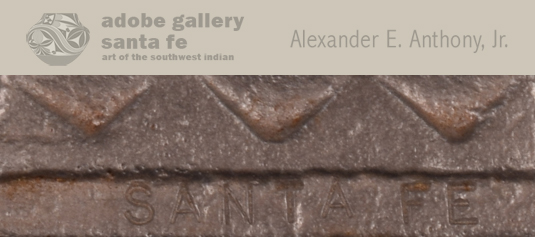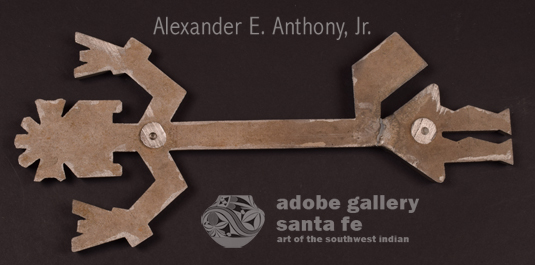Six Piece Fred Harvey Santa Fe Railroad Dining Car Ornaments [SOLD]
+ Add to my watchlist Forward to Friend
- Category: Other Items
- Origin: Western Artists
- Medium: Cast Aluminum
- Size:
Largest Piece: 10-¼” x 4-½”;
smallest: 4-½” x 4-½” - Item # C4169A SOLD

The Fred Harvey legend begins with the story of a young European immigrant who worked for the Chicago, Burlington & Quincy Railroad. As a freight agent, young Harvey became convinced that the food along the railroad heading West needed improvement. He believed that if travelers were offered something other than rancid meat and stale bread available at the roadhouse stops, the numbers of riders would increase. After his first employer declined to build restaurants, the *Atchison, Topeka and Santa Fe (AT&SF) contracted with Harvey to build several food outlets.
The Fred Harvey Company grew, and along with it the success of the AT&SF. Everyone from the Railroad officials to the passengers were impressed with the quality and service of the Harvey “eating houses.” By the late 1880s, there was a Fred Harvey dining facility located every 100 miles along the AT&SF. The business grew and, when Harvey died in 1901, his family inherited 45 restaurants and 20 dining cars in 12 states.
In the Fred Harvey hotels, cafes, gift shops and dining cars, the company used motifs that became analogous with the art and culture of the American Southwest. These designs included things like the thunderbird, crossed arrows and various plant and animal symbols that soon became associated with what was considered to be traditional Southwestern art.
These cast aluminum figures were part of a horizontal border near the ceiling of a Santa Fe dining car during the middle of the 20th century. Five of the pieces are representations of Yei figures, ^Diné spirit beings, who assist medicine men in curing ceremonies. Yei figures were often woven into Navajo textiles and depicted in sandpaintings that were sold to tourists. It is not surprising that the Fred Harvey Company would choose to use them as decor in their dining cars as they are part of the Diné culture. The remaining figure is that of the thunderbird, which became the logo of the Fred Harvey Company. The aluminum thunderbird has the words “Santa Fe” inscribed along the bottom of the figure.
These rare and unusual pieces of Fred Harvey memorabilia come from the collection of Fred Gurley, who was the president of the Santa Fe Railroad from 1944-1957. Gurley was best known for his work in connecting the railroad to Disneyland in the early part of the 1950s.
Condition: Three of the figures have been professionally repaired. Mounting posts on the back side have been removed.
Provenance: this Six Piece Fred Harvey Santa Fe Railroad Dining Car Ornaments is from a Santa Fe collector who purchased them from an auction of the collection of Fred Gurley
Recommended Reading: Inventing the Southwest by Kathleen L. Howard and Diana Pardue
*AT&SF: The Atchison, Topeka and Santa Fe Railway (reporting mark ATSF), often abbreviated as Santa Fe or AT&SF, was one of the larger railroads in the United States. Chartered in February 1859, the railroad reached the Kansas-Colorado border in 1873 and Pueblo, Colorado, in 1876. To create a demand for its services, the railroad set up real estate offices and sold farm land from the land grants that it was awarded by Congress. Despite the name, its main line never served Santa Fe, New Mexico, as the terrain was too difficult; the town ultimately was reached by a branch line from Lamy.
^Note: when we say Diné, as opposed to Navaho or Navajo, we are referring to the people and not the government. Since 1969, their government refers to itself as the Navajo Nation.

- Category: Other Items
- Origin: Western Artists
- Medium: Cast Aluminum
- Size:
Largest Piece: 10-¼” x 4-½”;
smallest: 4-½” x 4-½” - Item # C4169A SOLD



